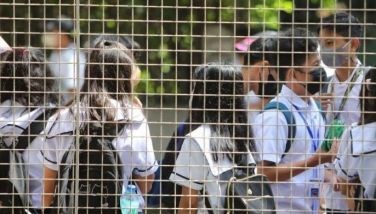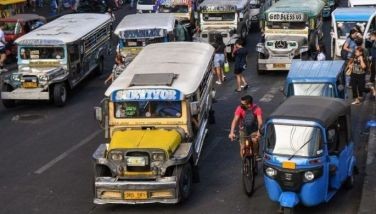Dysentery epidemic declared in Bohol
January 23, 2007 | 12:00am
The Department of Health (DOH) yesterday declared a dysentery epidemic in northern Bohol after a three-year-old child died and 110 others were stricken with the gastro-intestinal disease.
The child was identified as Leah May Lampara of barangay Cogon Norte in Loon town, which municipal health officer Dr. Tiro Miranda said may have a contaminated water supply.
Mayor Yul Lopez said authorities were looking into the source of the water supply contamination even as he assured the public that the epidemic had been contained.
He said the Agsoso spring, the only source out of the five water sources that filters water through a tank, may be contaminated with fecal matter. The Agsoso water supply is now closed to prevent further contamination.
Most of the residents downed by dysentery come from barangays Moto Norte, Moto Sur, Tabok, Cogon Norte, Basak, Badbad Oriental and Badbad Occidental.
Medicines were dispatched from the Provincial Health Office (PHO) to boost the supply at the Natalio Castillo Memorial Hospital, where many of the victims were admitted.
The victims developed acute diarrhea with bloody stools — indicating that they suffered from dysentery, which is characterized by the inflammation of the lining of the large intestines that cause abdominal pain and diarrhea with bowels containing mucus and blood.
Several types of microorganisms can cause dysentery but the shigella bacteria and amoeba are the most common cause of dysentery.
Dr. Eric Tayag, head of National Epidemiology Center (NEC), said health authorities in Bohol are looking into contaminated food and water as the possible causes of the outbreak.
"They are investigating (to see) if the (infected) residents have a common source of water there," Tayag said in an interview.
A three-man team of experts from the NEC is set to leave for Bohol today to assist in the investigation.
Stool samples were collected from the victims and will be analyzed to confirm their ailment.
According to Tayag, other dysentery victims from villages in Northern Bohol were rushed to the Don Emilio Del Valle Memorial Hospital in Ligay town, where they received intravenous rehydration and antibiotics.
Hospital officials observed that diarrhea cases began to pour in from Northern Bohol starting Dec. 16, 2006. On Friday, however, they raised an alert after some 50 people were rushed to the hospital for diarrhea, Tayag said.
He said 10 percent of dysentery patients usually die if they’re not given immediate and proper treatment. — With Peter Dejaresco
The child was identified as Leah May Lampara of barangay Cogon Norte in Loon town, which municipal health officer Dr. Tiro Miranda said may have a contaminated water supply.
Mayor Yul Lopez said authorities were looking into the source of the water supply contamination even as he assured the public that the epidemic had been contained.
He said the Agsoso spring, the only source out of the five water sources that filters water through a tank, may be contaminated with fecal matter. The Agsoso water supply is now closed to prevent further contamination.
Most of the residents downed by dysentery come from barangays Moto Norte, Moto Sur, Tabok, Cogon Norte, Basak, Badbad Oriental and Badbad Occidental.
Medicines were dispatched from the Provincial Health Office (PHO) to boost the supply at the Natalio Castillo Memorial Hospital, where many of the victims were admitted.
The victims developed acute diarrhea with bloody stools — indicating that they suffered from dysentery, which is characterized by the inflammation of the lining of the large intestines that cause abdominal pain and diarrhea with bowels containing mucus and blood.
Several types of microorganisms can cause dysentery but the shigella bacteria and amoeba are the most common cause of dysentery.
Dr. Eric Tayag, head of National Epidemiology Center (NEC), said health authorities in Bohol are looking into contaminated food and water as the possible causes of the outbreak.
"They are investigating (to see) if the (infected) residents have a common source of water there," Tayag said in an interview.
A three-man team of experts from the NEC is set to leave for Bohol today to assist in the investigation.
Stool samples were collected from the victims and will be analyzed to confirm their ailment.
According to Tayag, other dysentery victims from villages in Northern Bohol were rushed to the Don Emilio Del Valle Memorial Hospital in Ligay town, where they received intravenous rehydration and antibiotics.
Hospital officials observed that diarrhea cases began to pour in from Northern Bohol starting Dec. 16, 2006. On Friday, however, they raised an alert after some 50 people were rushed to the hospital for diarrhea, Tayag said.
He said 10 percent of dysentery patients usually die if they’re not given immediate and proper treatment. — With Peter Dejaresco
BrandSpace Articles
<
>
- Latest
- Trending
Trending
Latest
Trending
Latest
Recommended































